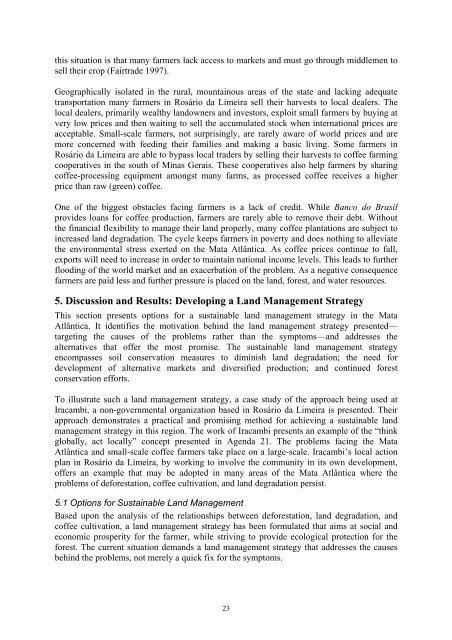Deforestation, Coffee Cultivation, and Land Degradation ... - lumes
Deforestation, Coffee Cultivation, and Land Degradation ... - lumes
Deforestation, Coffee Cultivation, and Land Degradation ... - lumes
You also want an ePaper? Increase the reach of your titles
YUMPU automatically turns print PDFs into web optimized ePapers that Google loves.
this situation is that many farmers lack access to markets <strong>and</strong> must go through middlemen tosell their crop (Fairtrade 1997).Geographically isolated in the rural, mountainous areas of the state <strong>and</strong> lacking adequatetransportation many farmers in Rosário da Limeira sell their harvests to local dealers. Thelocal dealers, primarily wealthy l<strong>and</strong>owners <strong>and</strong> investors, exploit small farmers by buying atvery low prices <strong>and</strong> then waiting to sell the accumulated stock when international prices areacceptable. Small-scale farmers, not surprisingly, are rarely aware of world prices <strong>and</strong> aremore concerned with feeding their families <strong>and</strong> making a basic living. Some farmers inRosário da Limeira are able to bypass local traders by selling their harvests to coffee farmingcooperatives in the south of Minas Gerais. These cooperatives also help farmers by sharingcoffee-processing equipment amongst many farms, as processed coffee receives a higherprice than raw (green) coffee.One of the biggest obstacles facing farmers is a lack of credit. While Banco do Brasilprovides loans for coffee production, farmers are rarely able to remove their debt. Withoutthe financial flexibility to manage their l<strong>and</strong> properly, many coffee plantations are subject toincreased l<strong>and</strong> degradation. The cycle keeps farmers in poverty <strong>and</strong> does nothing to alleviatethe environmental stress exerted on the Mata Atlântica. As coffee prices continue to fall,exports will need to increase in order to maintain national income levels. This leads to furtherflooding of the world market <strong>and</strong> an exacerbation of the problem. As a negative consequencefarmers are paid less <strong>and</strong> further pressure is placed on the l<strong>and</strong>, forest, <strong>and</strong> water resources.5. Discussion <strong>and</strong> Results: Developing a L<strong>and</strong> Management StrategyThis section presents options for a sustainable l<strong>and</strong> management strategy in the MataAtlântica. It identifies the motivation behind the l<strong>and</strong> management strategy presented—targeting the causes of the problems rather than the symptoms—<strong>and</strong> addresses thealternatives that offer the most promise. The sustainable l<strong>and</strong> management strategyencompasses soil conservation measures to diminish l<strong>and</strong> degradation; the need fordevelopment of alternative markets <strong>and</strong> diversified production; <strong>and</strong> continued forestconservation efforts.To illustrate such a l<strong>and</strong> management strategy, a case study of the approach being used atIracambi, a non-governmental organization based in Rosário da Limeira is presented. Theirapproach demonstrates a practical <strong>and</strong> promising method for achieving a sustainable l<strong>and</strong>management strategy in this region. The work of Iracambi presents an example of the “thinkglobally, act locally” concept presented in Agenda 21. The problems facing the MataAtlântica <strong>and</strong> small-scale coffee farmers take place on a large-scale. Iracambi’s local actionplan in Rosário da Limeira, by working to involve the community in its own development,offers an example that may be adopted in many areas of the Mata Atlântica where theproblems of deforestation, coffee cultivation, <strong>and</strong> l<strong>and</strong> degradation persist.5.1 Options for Sustainable L<strong>and</strong> ManagementBased upon the analysis of the relationships between deforestation, l<strong>and</strong> degradation, <strong>and</strong>coffee cultivation, a l<strong>and</strong> management strategy has been formulated that aims at social <strong>and</strong>economic prosperity for the farmer, while striving to provide ecological protection for theforest. The current situation dem<strong>and</strong>s a l<strong>and</strong> management strategy that addresses the causesbehind the problems, not merely a quick fix for the symptoms.23
















